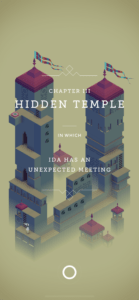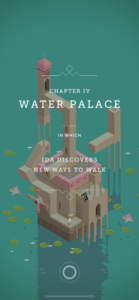For this critical play, I played 5 levels of Monument Valley, a paid interactive puzzle game that requires manipulation and movement through seemingly impossible architecture and geometry, created by Ustwo and available for Android, iOS, and Microsoft Windows (I played on an iPhone), and perfect for explorer and achiever player types.
Argument: The constantly evolving and unexpected modes of movement in the game space creates a blended emergent and embedded narrative in which discovery of new puzzle mechanics drives the experience forwards. Additionally, the delivery of different puzzles as chapters and the dialogue embedded in key achievement points within a puzzle add an extra layer of sophistication that drive a narrative forward and create enjoyment beyond purely puzzle solving mechanics.
The constant evolution of navigation mechanics in each level keeps players challenged and forces them to explore the puzzle’s architecture in new ways. It is not always obvious what components of the structure are manipulable or accepting of movement.The first chapter introduces you to the dial turning mechanic that can change the positioning of the path blocks that it is attached to. However, after that point you are mostly on your own (based on the 5 chapters I played) and it is up to you to poke around and test new theories. For example, I initially did not realize that blocks with the column of holes on their side could be moved up and down, and in subsequent chapters it still was a guess at which stationary blocks would be affected by the block’s motion.
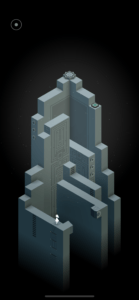
Chapter 4 was particularly complex as it involved multiple stages of puzzle solving within a single chapter, adopting mechanics such as dial turning, stair rotation, walking sideways, teleportation, etc. Each of the 4 movement mechanics were discoveries I had to make independently through exploration, often failing to make use of them correctly the first time. At one point, during a sideways wall walking endeavor, I accidentally walked behind the castle and couldn’t figure out how to return; after more trial and error, I realized that the base of the castle could be completely rotated. See the screenshot below.
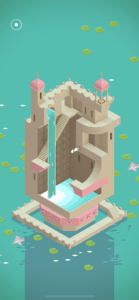
The layering of each new puzzle mechanic creates a strong sense of achievement as you progress through the levels and become more skilled at using them effectively. In the later levels, I found myself able to mentally map how to get from point A to point B and the manipulations I would perform to get there. However, even then, planning ahead is not entirely possible as unpredictability exists even for a fixed mechanic e.g. the discovery of which surrounding blocks a sliding block changes; it may also be unclear how long a single chapter is supposed to be, as was the case with Chapter 4. I thought I had solved the level but a new structure emerged from the mist instead. The similarity in style of the end of chapter portal dots to navigation related shapes throughout the chapter are also an element that can create confusion and surprise about the chapter length. The combination of all of the above both cause the player to create their own narrative of how/how fast they solved a level and also create a sense of anticipation and curiosity about how future chapters will unfold. In the screenshot of Chapter 4 below, a pink bridge emerged from the water carrying me from one structure to the next and creating a greater sense of space and travel within the virtual world.
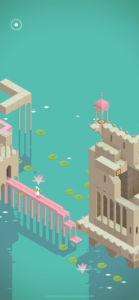
The style of puzzle delivery as chapters of an unfolding story created an embedded narrative that extend beyond purely the player’s personal puzzle solving challenges. The first chapter begins setting the game’s premise, a solo traveler named Ida on a mission – but we as players do not initially know what (keep in mind I only played 5 chapters). In some chapters, new plot elements are added e.g. introducing Ida to the ghost character, providing some backstory of the monuments’ existence etc. In the middle of Chapter 3 “The Hidden Temple” seen below, players witness a series of questions from the ghost for Ida: “How far have you wandered, silent princess?”, “Why are you here?”, etc. These questions don’t reveal any information but provoke the player to start formulating their own theories as to why she travels.
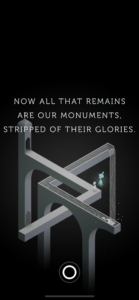
Interestingly, Ida never directly interacts with the speaking characters – she is a silent and faceless traveler- creating more intrigue and allows for the player to develop their own theories as to why she is travelling. However, hints as to her purpose and destination are embedded in the transition points between chapters. At the end of each chapter, we observe that she removes her hat in front of the final geometric square, placing down an item. As players, we are led to realize that these items are things that must be returned at unique locations that she had previously taken them from. Each chapter also inherently drives the story forward by taking place in a new location. The naming and theming of each location creates an evocative and sensory fun for the player, allowing them to build some conceptual model of how the different locations fit together in the narrative. The chapter names and the subtitles provide additional information beyond the specifics that are delivered within a chapter. Besides setting the location, “hidden temple” or “water palace” they give a sense of what is to come e.g. “Ida has an unexpected meeting” in Chapter 3 and Chapter 4 which is titled “Ida Discovers New Ways to Walk” alludes to the discovery of being able to walk sideways along walls. See the chapter 3 and 4 screens and their titles/subtitles below.
